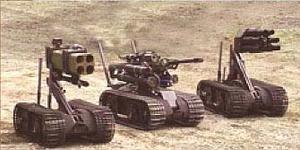Killer robotsAutonomous weapons which select, destroy targets without human intervention proliferate
More scientists are expressing concern over autonomous weapons which are able to select and destroy targets without human control or oversight. Armed drones can be operated by remote pilots, but weapons of the future will rely more on artificial intelligence to decide what to target and whom to kill.

Examples of totally autonomous weapons // Source: blogfa.com
More scientists are expressing concern over autonomous weapons which are able to select and destroy targets without human control or oversight. Armed drones can be operated by remote pilots, but weapons of the future will rely more on artificial intelligence to decide what to target and whom to kill. The United Nations this week is hosting representatives from concerned nations to discuss whether developments of what critics call “killer robots” should be restricted by the Convention on Certain Conventional Weapons. The Pentagon has issued a directive requiring high-level authorization for the development of autonomous weapons, but some countries have already developed such weapons, while others are preparing to do so.
Israel’s anti-radar missile, the Harpy, loiters the sky until an enemy radar is turned on. It then attacks and destroys the radar installation on its own. Norway plans to equip its fleet of advanced jet fighters with the Joint Strike Missile, which according to theNew York Times, can hunt, recognize, and detect a target without human intervention. Britain’s “fire and forget” Brimstone missiles can distinguish among tanks, cars, and buses without human control. The Brimstones can also hunt targets in an assigned region without oversight, and communicate with one another, sharing their targets. “Our concern is with how the targets are determined, and more importantly, who determines them,” said Peter Asaro, a co-founder and vice chairman of the International Committee for Robot Arms Control. “Are these human-designated targets? Or are these systems automatically deciding what is a target?”
In 1988, the U.S. Navy test-fired a Harpoon antiship missile equipped with an early form of self-guidance. The missile mistook Jagvivek, an Indian merchant ship that had strayed onto the test range in the Navy’s Pacific Missile Range, for its target. Luckily, the Harpoon was not armed, but it did hit the ship’s bridge, killing a crew member. At least a dozen militaries are equipped with the Harpoon today.
TheTimes credits technological advances in three areas for making autonomous weapons a possibility. Improved radar, laser, and infrared sensors are helping missiles and drones calculate their positions and that of their targets more precisely; “machine vision,” similar to that of humans, has improved to help weapons distinguish targets; and the computer hardware needed to host the weapons have become relatively inexpensive and expendable. Christof Heyns, the United Nations Special Rapporteur on extrajudicial, summary, or arbitrary executions, has called on nations with advanced weapons to agree to limit their weapons systems to actors with “meaningful” human control over the selection of targets. He warns that some autonomous weapons systems permit humans to override their decisions but some weapons move so quickly that human monitors may not be able to take control.
